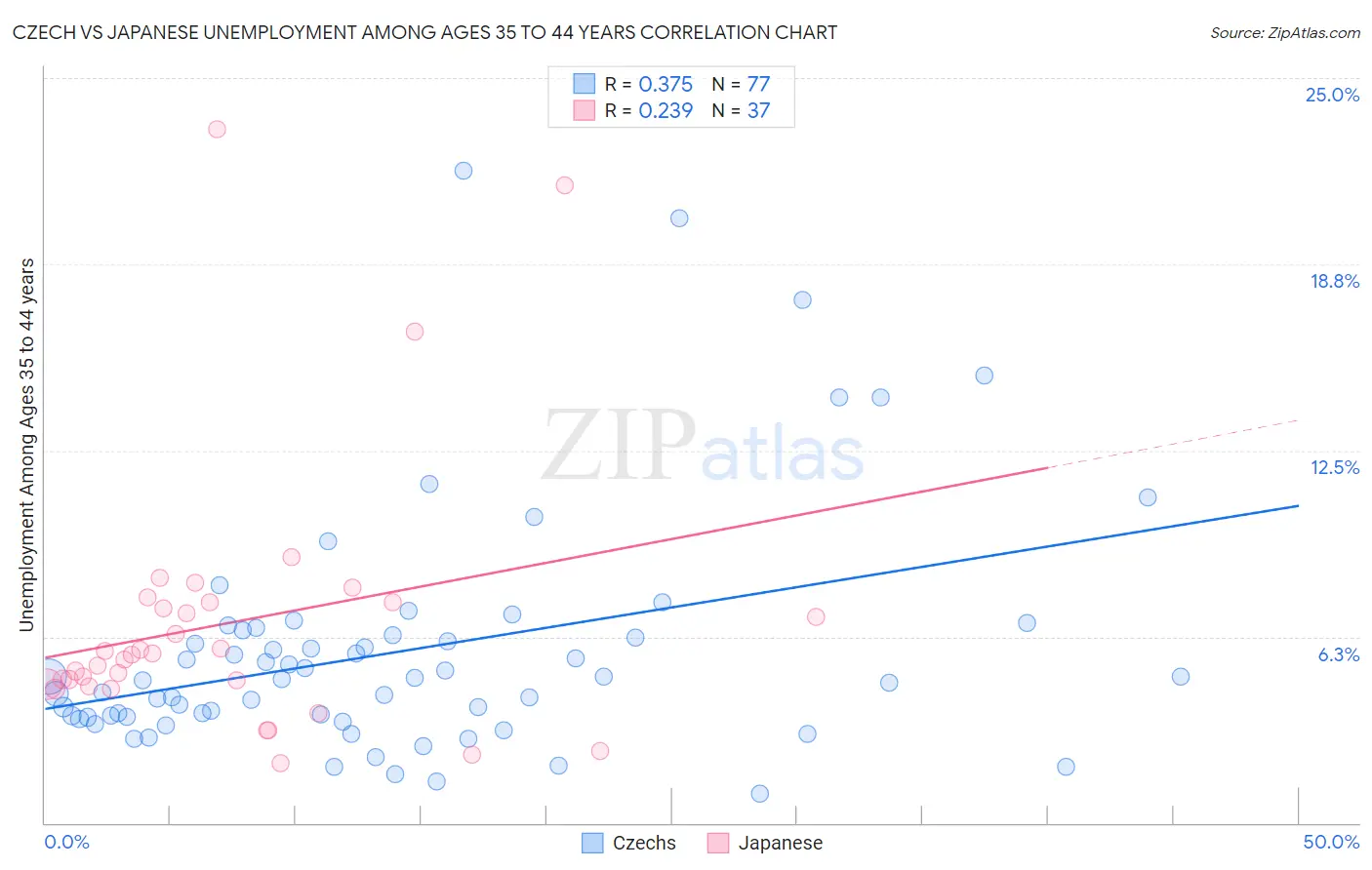Czech vs Japanese Unemployment Among Ages 35 to 44 years
COMPARE
Czech
Japanese
Unemployment Among Ages 35 to 44 years
Unemployment Among Ages 35 to 44 years Comparison
Czechs
Japanese
4.1%
UNEMPLOYMENT AMONG AGES 35 TO 44 YEARS
99.9/ 100
METRIC RATING
14th/ 347
METRIC RANK
5.1%
UNEMPLOYMENT AMONG AGES 35 TO 44 YEARS
1.2/ 100
METRIC RATING
231st/ 347
METRIC RANK
Czech vs Japanese Unemployment Among Ages 35 to 44 years Correlation Chart
The statistical analysis conducted on geographies consisting of 462,421,231 people shows a mild positive correlation between the proportion of Czechs and unemployment rate among population between the ages 35 and 44 in the United States with a correlation coefficient (R) of 0.375 and weighted average of 4.1%. Similarly, the statistical analysis conducted on geographies consisting of 246,537,805 people shows a weak positive correlation between the proportion of Japanese and unemployment rate among population between the ages 35 and 44 in the United States with a correlation coefficient (R) of 0.239 and weighted average of 5.1%, a difference of 21.9%.

Unemployment Among Ages 35 to 44 years Correlation Summary
| Measurement | Czech | Japanese |
| Minimum | 1.0% | 2.0% |
| Maximum | 21.9% | 23.3% |
| Range | 20.9% | 21.3% |
| Mean | 5.8% | 6.7% |
| Median | 4.8% | 5.6% |
| Interquartile 25% (IQ1) | 3.6% | 4.6% |
| Interquartile 75% (IQ3) | 6.4% | 7.4% |
| Interquartile Range (IQR) | 2.8% | 2.8% |
| Standard Deviation (Sample) | 4.0% | 4.5% |
| Standard Deviation (Population) | 4.0% | 4.5% |
Similar Demographics by Unemployment Among Ages 35 to 44 years
Demographics Similar to Czechs by Unemployment Among Ages 35 to 44 years
In terms of unemployment among ages 35 to 44 years, the demographic groups most similar to Czechs are Tongan (4.2%, a difference of 0.080%), Bolivian (4.1%, a difference of 0.10%), Venezuelan (4.1%, a difference of 0.14%), Sudanese (4.1%, a difference of 0.24%), and Immigrants from Singapore (4.1%, a difference of 0.31%).
| Demographics | Rating | Rank | Unemployment Among Ages 35 to 44 years |
| Immigrants | Cuba | 99.9 /100 | #7 | Exceptional 4.1% |
| Immigrants | South Central Asia | 99.9 /100 | #8 | Exceptional 4.1% |
| Danes | 99.9 /100 | #9 | Exceptional 4.1% |
| Immigrants | Singapore | 99.9 /100 | #10 | Exceptional 4.1% |
| Sudanese | 99.9 /100 | #11 | Exceptional 4.1% |
| Venezuelans | 99.9 /100 | #12 | Exceptional 4.1% |
| Bolivians | 99.9 /100 | #13 | Exceptional 4.1% |
| Czechs | 99.9 /100 | #14 | Exceptional 4.1% |
| Tongans | 99.8 /100 | #15 | Exceptional 4.2% |
| Cubans | 99.8 /100 | #16 | Exceptional 4.2% |
| Swedes | 99.8 /100 | #17 | Exceptional 4.2% |
| Latvians | 99.8 /100 | #18 | Exceptional 4.2% |
| Immigrants | Nepal | 99.7 /100 | #19 | Exceptional 4.2% |
| Immigrants | Bolivia | 99.7 /100 | #20 | Exceptional 4.2% |
| Paraguayans | 99.6 /100 | #21 | Exceptional 4.2% |
Demographics Similar to Japanese by Unemployment Among Ages 35 to 44 years
In terms of unemployment among ages 35 to 44 years, the demographic groups most similar to Japanese are Liberian (5.1%, a difference of 0.030%), Iroquois (5.1%, a difference of 0.080%), Immigrants from Nigeria (5.1%, a difference of 0.13%), Portuguese (5.1%, a difference of 0.19%), and Immigrants from Cambodia (5.0%, a difference of 0.31%).
| Demographics | Rating | Rank | Unemployment Among Ages 35 to 44 years |
| Panamanians | 2.9 /100 | #224 | Tragic 5.0% |
| Immigrants | Lebanon | 2.7 /100 | #225 | Tragic 5.0% |
| Potawatomi | 2.5 /100 | #226 | Tragic 5.0% |
| Immigrants | Uzbekistan | 1.9 /100 | #227 | Tragic 5.0% |
| Samoans | 1.8 /100 | #228 | Tragic 5.0% |
| Immigrants | Cambodia | 1.5 /100 | #229 | Tragic 5.0% |
| Liberians | 1.3 /100 | #230 | Tragic 5.1% |
| Japanese | 1.2 /100 | #231 | Tragic 5.1% |
| Iroquois | 1.2 /100 | #232 | Tragic 5.1% |
| Immigrants | Nigeria | 1.2 /100 | #233 | Tragic 5.1% |
| Portuguese | 1.1 /100 | #234 | Tragic 5.1% |
| Guamanians/Chamorros | 0.9 /100 | #235 | Tragic 5.1% |
| Central Americans | 0.8 /100 | #236 | Tragic 5.1% |
| Kiowa | 0.8 /100 | #237 | Tragic 5.1% |
| Hondurans | 0.7 /100 | #238 | Tragic 5.1% |